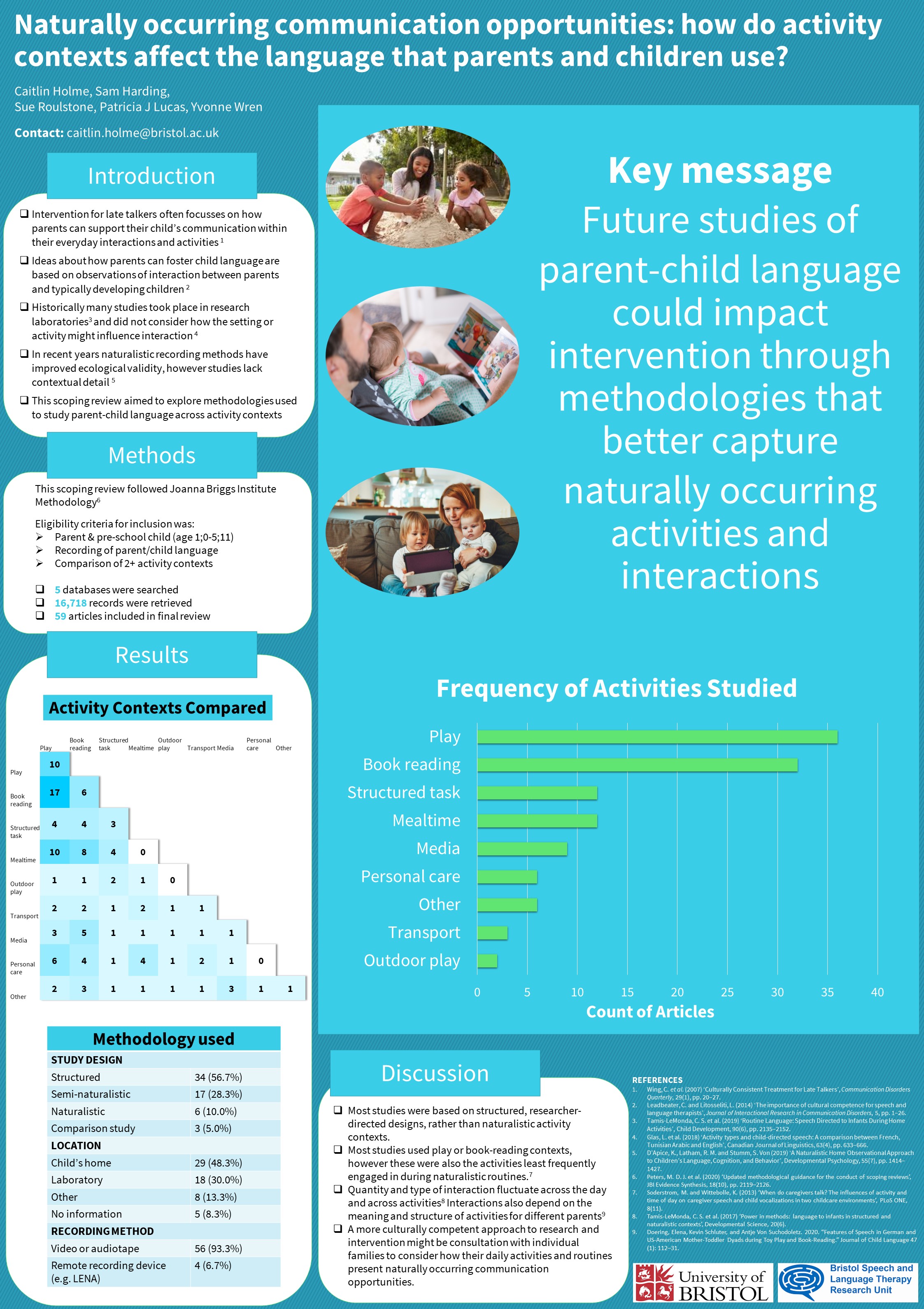Caitlin Holme - University of Bristol/Bristol Speech & Language Therapy Research Unit

Naturally occurring communication opportunities: how do activity contexts affect the language that parents and children use?
Caitlin Holme,1,2 Sam Harding,1Sue Roulstone,1,3 Patricia J Lucas4, Yvonne Wren1,2
- Bristol Speech and Language Therapy Research Unit, North Bristol NHS Trust 2. Faculty of Health Sciences, University of Bristol
- Centre for Health and Applied Sciences, University of the West of England 4. School for Policy Studies, University of Bristol
Abstract
Children do not acquire language in a vacuum, but in the context of everyday interactions with the people around them (Sperry & Sperry, 2016). Intervention for children who are late talkers often focusses on techniques for parents to support their child’s communication within their everyday interactions and routines (Wing et al., 2007). Research shows that interventions are most effective when embedded within children’s everyday activities (Dunst, Raab, & Hamby, 2016). However, despite the value of naturally occurring daily routines as a source of language input for children, research has often neglected to consider the influence of activity on the language that parents and children use (Glas et al., 2018).
We conducted a scoping review in accordance with the Joanna Briggs Institute methodology (Peters et al., 2020). The aim was to explore the breadth of literature about how parents and children use language across different activity contexts. Five databases were searched and a total of 16,718 records were retrieved. Of these, 59 articles were selected for final data charting. A thematic analysis identified key areas of activity that have been frequently studied in the language development literature, including toy-play, book reading and media.
In this poster, we will summarise findings of the scoping review and reflect on whether existing literature is representative of how children use language during their real-life daily activity contexts. We will consider ways that future research and intervention practices might incorporate naturally occurring communication opportunities to ensure appropriate intervention for children and families.
References:
Dunst, C. J., Raab, M., & Hamby, D. W. (2016). Interest-based everyday child language learning. Revista de Logopedia, Foniatria y Audiologia, 36(4), 153–161.
https://doi.org/10.1016/j.rlfa.2016.07.003
Glas, L., Rossi, C., Hamdi-Sultan, R., Batailler, C., & Bellemmouche, H. (2018). Activity types and child directed speech: A comparison between French, Tunisian Arabic and English. Canadian Journal of Linguistics, 63(4), 633–666. https://doi.org/10.1017/cnj.2018.20
Peters, M. D. J., Godfrey, C., McInerney, P., Munn, Z., Tricco, A. C., & Khalil, H. (2020). Chapter 11: Scoping Reviews (2020 version). In E. Aromataris & Z. Munn (Eds.), JBI Manual for Evidence Synthesis. JBI. https://doi.org/10.46658/jbimes-20-12
Sperry, D. E., & Sperry, L. L. (2016). Counting in Context: Studying children’s everyday talk by combining numbers and words. In J. Prior & J. Van Herwegen (Eds.), Practical Research with Children (1st ed.). Routledge.
Sugden, E., Munro, N., Trivette, C. M., Baker, E., & Williams, A. L. (2019). Parents’ Experiences of Completing Home Practice for Speech Sound Disorders. Journal of Early Intervention, 41(2), 159–181. https://doi.org/10.1177/1053815119828409
Wing, C., Kohnert, K., Pham, G., Cordero, K. N., Ebert, K. D., Fong Kan, P., & Blaiser, K. (2007). Culturally Consistent Treatment for Late Talkers. Communication Disorders Quarterly, 29(1), 20–27.
